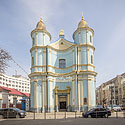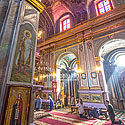Ukraine
Ivano-Frankivsk region
Ivano-Frankivsk and surroundings
Ivano-Frankivsk
Worth seeing
Worth seeing in Ivano-Frankivsk
-
Armenian Church
The church with two towers of the late Baroque style was built in XVIII c. on the place of the wooden one. Two restorations, in XIX and in XX cc. had changed its look. In the interior there are wooden sculptures that are supposed to be the works of M. Poleyovsky. There are also wall paintings done by Y. Soletsky. Now it is the cathedral of the Intercession of Ukrainian Orthodox church.Address: Ivano-Frankivsk, Virmenska St. 6 -
Brewery
The whole complex includes several buildings, two of them, cooking and malt departments, are the oldest (1767). They are monuments of industrial architecture built in Baroque style and rare ones nowadays that are used according to their intended purpose.Address: Ivano-Frankivsk, Novhorodska St., 49 -
Church of Jesuits
The church (1753-1763) is one of the oldest architectural monuments in the city. It was built in the Baroque style under the guidance of S. Pototsky, the engineer-fortifier, the author of the fortifications in Kamyanets-Podilsky and Częstochowa. Further restorations had not changed the architectural forms of the church. Now it is the Greek-Catholic Cathedral of the Resurrection.Address: Ivano-Frankivsk, A. Sheptytsky Sq., 22 -
City Hall
The City Hall in Ivano-Frankivsk is one of the rare structures built in modern style, more exactly — in Art Deco style. It is the fourth building of the local City Hall (1929-1935). Stanislaw Trelya, the architect, guided the building. The modern building of the City Hall represents the cross. From its intersection there rises the bell tower 49,5 m high. Its cupola is vermeiled, so the building is just one among secular architecture of the kind in Ukraine. The City Hall is in the TOP five of the Western Ukraine. Now the Museum of Regional Ethnography is located here.Address: Ivano-Frankivsk, Halytska St. 4-a -
City Savings Bank Office
The building opened its doors in 1884. It was one of the most impressive buildings in the city. The project of Raymond Reus, the Krakow architect, with some ideas of Jan Sporka, the local master, was the base of the structure. Soon a two-storey building with pleasant architectural forms and a hip tiled roof appeared in the city. Above the main facade an allegorical sculptural group made by T. Dykas, was erected. It symbolizes labour and economy. At early XX c. the building went through the total reconstruction. But it never changed its designation. Today the Regional Board of Savings Banks is located here.Address: Ivano-Frankivsk, Hetman Mazepa St. 14 -
Collegiate church of the Holy Virgin
Today the Regional Art Museum is situated here. The former Catholic church is one of the oldest buildings in the city that had been preserved practically without changes. Architects — K. Banoye and F. Korasini (the author of the fortress). At the second half of the XIX c. E. Fabiansky painted the church inside. In 1669 the church got the rank of the collegium — a school was organized here, a branch of Krakow academy, 200 people studied there.Address: Ivano-Frankivsk, A. Sheptytsky Sq., 8 -
Directorate of Railways
The building of the former Directorate of Railways, later — that of local authorities, was built in 1893-1894 (architect E. Baudish, Vienna). It is a monument of the neo-Renaissance style. Now it is the main building of the local medical university.Address: Ivano-Frankivsk, Halytska St. 2 -
Former Jewish cemetery
Кладовище діяло з 1926 р. по 1967 р. Його обнесли високим цегляним муром. Неподалік від головного входу стояли велика синагога й господарський будинок.
За німецької окупації цвинтар перетворився на арену масових розстрілів. Віддаленість від центру, закритість від сторонніх очей і значні розміри робили його ідеальним місцем для страт. Вперше фашисти випробували цвинтар 12 жовтня 1941 року. Тоді під кулеметами загинуло близько 10 000 осіб. В подальшому екзекуції тривали, але масштаби були скромніші.
З наближенням фронту для того щоб приховати сліди геноциду, німці вдавалися до особливо жорстоких заходів. Втім приховати загибель десятків тисяч людей у невеличкому місті було неможливо.
Після приходу совітів до Станіслава було створено міську комісію «По розслідуванню звірств німецько-фашистських загарбників».
Досі в обласному архіві зберігається акт огляду єврейського цвинтаря від 29 листопада 1944 року. У ньому цвинтар називають «табором смерті» та наводять аргументи, що підтверджують жорстокі дії німців.
На давніх фото добре видно, що на багатьох похованнях знищені мацеви — вертикальні кам’яні плити з написами про померлого. Ті, що залишилися, доламали вже у радянські часи. Згодом Радянські комунальники використовували їх в якості бордюрів.
Однак в місто прибували нові євреї, а цвинтар продовжував працювати до 1967 р. Тоді його закрили, а юдеїв стали ховати на загальноміських кладовищах.Address: Ivano-Frankivsk -
Fortification Walls and Ramparts
The fortress appeared practically together with the city. It was constructed in a short period (5 months) under the guidance of Fransua Korasini, a French engineer. It looked like a hexagon with additional fortifications. The Pototsky Palace was located inside them.Address: Ivano-Frankivsk, Nyzova St., Fortechny lane, Valova St. -
Jesuit Collegium
The Academy was reorganized in 1728 into the Jesuit collegium. A new building for it was built in 1733-1734. It is a local monument of Baroque style. In 1784-1867 the German high school was located here, till 1939 — the Polish one. Its prominent graduates are O. Terletsky, Y. Tselevych, D. Vitovsky. Now one of the departments of the local medical university is situated here.Address: Ivano-Frankivsk, A. Sheptytsky Sq., 21 -
Pototsky Palace
The complex includes the Palace itself and the gateway (1672-1682). The stone palace was built for the Pototsky family inside the fortress. At the beginning of XIX c. the last owner sold the residence because of financial problems. Later the military hospital was situated here. And the planning of all the buildings was thoroughly changed. Today this medical establishment can be considered to be one of the oldest in Europe.Address: Ivano-Frankivsk, Shpytalna St., 5 -
Railway Station
The railway station was built in 1866. Here the elements of Moorish style were used: narrow semicircular windows, ribbed columns. It was also the time when the first railway from Lviv via Ivano-Frankivsk to Yassy (Romania) was constructed. The building of the railway station was the first in the city to be illuminated with electricity.Address: Ivano-Frankivsk, Pryvokzalna Sq. 8

 Ukraine
Ukraine Poland
Poland Slovakia
Slovakia
 Українською
Українською




















